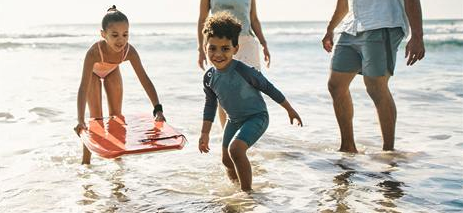When the weather is pleasant, families often head to the water. Whether you prefer the ocean, a river, or a lake, these tips will help ensure your fun time remains hazard-free.
Select a Safe Location
Opt for Lifeguarded Beaches: Always choose beaches with lifeguards on duty.
Check Water Quality: Be aware of notices about water quality, rip currents, and shorebreaks. Remember, high bacteria levels in water also mean unsafe sand.
Inspect the Sand: Before setting up, check for sharp debris or washed-up items like sticks, bottles, or jellyfish. (Know how to treat jellyfish stings just in case.)
Safe Sand Play
Monitor Sand Holes: While building sandcastles, ensure holes are no deeper than the child's knee to prevent accidents. Avoid digging in sand dunes and always fill in holes before leaving.
Watch Water Temperature: Ideal swimming temperatures are between 82°F and 86°F (28°C to 30°C). If not posted, ask the lifeguard.
Be Weather-Wise
Heed Lightning Warnings: Seek shelter at the first sound of thunder, preferably in a sturdy building or a hard-topped vehicle. Wait at least 30 minutes after the storm passes before returning.
Shoreline Safety
Teach Water Respect: Kids should face the water to watch for waves and enter feet-first to gauge temperature and depth. Avoid diving from high points to prevent injuries.
Designate a Water Watcher: An adult with strong swimming skills should always keep an eye on the water, free from distractions like phones or alcohol.
Use Life Jackets Wisely: Young or weak swimmers should wear life jackets. Everyone should wear them when boating or participating in water sports.
Require Adult Permission: Kids should always check with an adult before entering the water.
Implement the Buddy System: For young kids, this means staying within arm's reach of an adult. Older kids should stick together in groups, and no one should swim alone.
Prevent Sunburn and Heat Illness
Prepare Your Skin: Use SPF 30+ broad-spectrum sunscreen, applying it 30 minutes before exposure. Reapply every two hours or after swimming.
Protect Infants: For babies under six months, use hats and lightweight clothing instead of sunscreen. Find a shady spot for them to play or nap.
Use Protective Beachwear: Rash guards and long-sleeved tops offer extra protection, especially during peak UV hours (10 a.m. to 4 p.m.). Protect feet from hot sand with appropriate footwear.
Seek Shade: Securely anchor beach umbrellas and remember that they don’t provide full UV protection.
Stay Cool and Hydrated: Ensure kids drink plenty of water and take shade breaks to avoid heat illness.
By following these tips, you can ensure a safe and enjoyable beach outing for the entire family.

